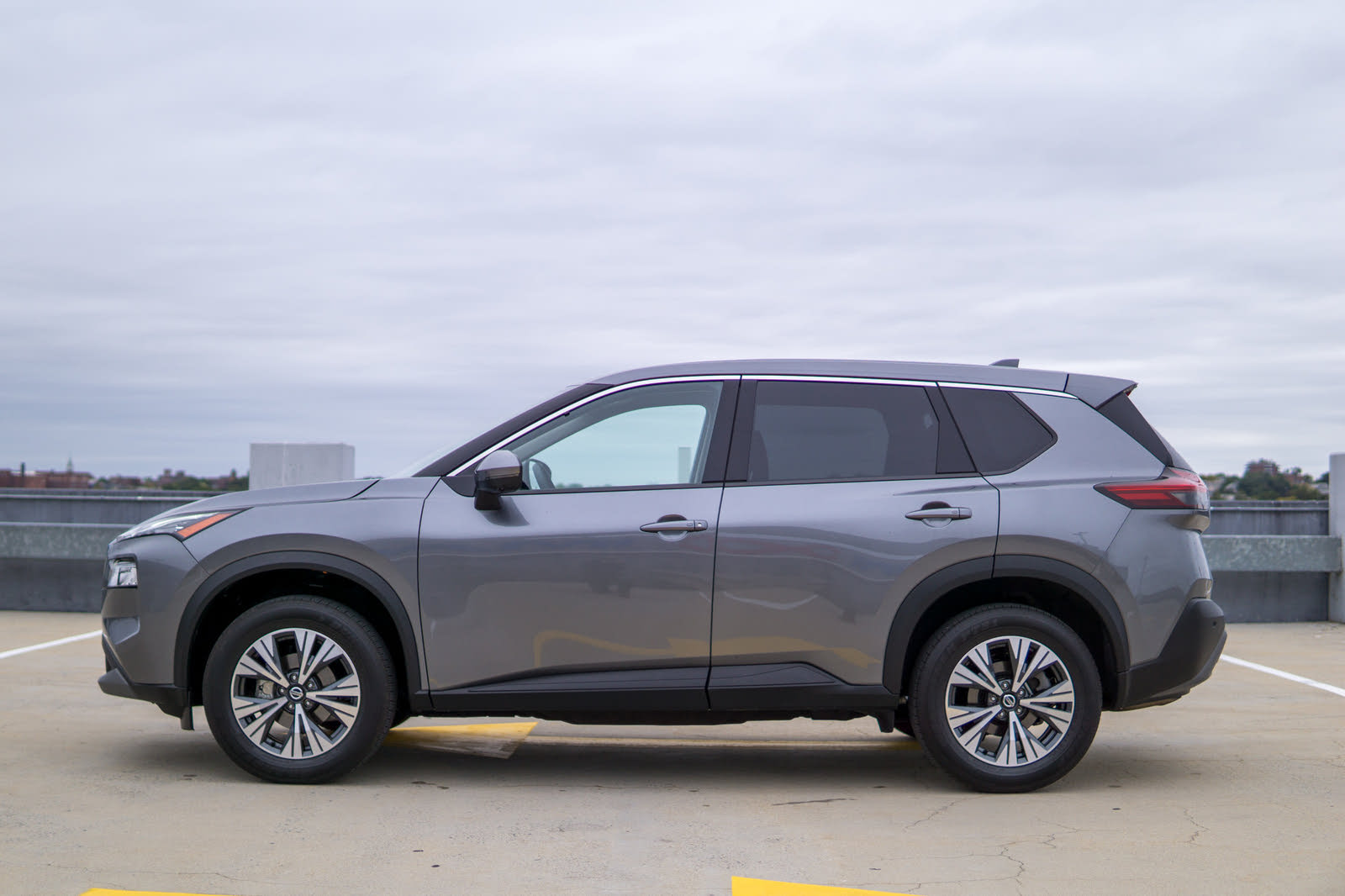2021 Nissan Rogue vs 2020 Land Rover Range Rover Sport
Overview | |
MSRP$68,650 | MSRP$26,050 |
Listings375 | Listings2468 |
Ratings & Reviews | |
User Reviews | User Reviews |
Expert reviews6.7 out of 10 | Expert reviews9.0 out of 10 |
Pros
Cons
| Pros
Cons
|
2020 Land Rover Range Rover Sport Reviews SummaryWhen you think of a plug-in hybrid electric vehicle (PHEV), the image of a dorky little hatchback car probably pops into your mind. The new 2020 Land Rover Range Rover Sport PHEV, however, is an entirely different kind of electrified vehicle. Land Rover says it retains all of its traditional land-roving capabilities while delivering greater efficiency. Based on our week-long test in this SUV’s natural habitat (the swanky suburbs of a big city), it does get remarkably good fuel economy. | |
2021 Nissan Rogue Reviews SummaryTo characterize the all-new 2021 Nissan Rogue as vital to the automaker's success is an understatement. Not only is the compact crossover SUV the best-selling Nissan in America, but it's also one of the best-selling vehicles in America. Strip out pickup trucks, and the Rogue sits near the top of the U.S. sales chart with its primary competitors, the Honda CR-V and Toyota RAV4. Imagine the pressure on Nissan designers, engineers, and product planners as they prepared the current Rogue's replacement! The good news is that the new Rogue is a better SUV in every way but one. | |
Popular Features & Specs | |
Engine3.0L 355 hp I6 | Engine2.5L 181 hp I4 |
Drive TrainAWD | Drive TrainFWD |
Seating Capacity7 | Seating Capacity5 |
Horsepower355 hp @ 5500 rpm | Horsepower181 hp @ 6000 rpm |
EV Battery Capacity0.2 kWh | EV Battery Capacity |
MPG City19 | MPG City27 |
MPG Highway24 | MPG Highway35 |
Engine | |
Engine Name3.0L 355 hp I6 | Engine Name2.5L 181 hp I4 |
Torque365 lb-ft @ 2000 rpm | Torque181 lb-ft @ 3600 rpm |
Horsepower355 hp @ 5500 rpm | Horsepower181 hp @ 6000 rpm |
DrivetrainAWD | DrivetrainFWD |
Fuel Economy | |
EV Battery Capacity0.2 kWh | EV Battery Capacity |
MPG City19 | MPG City27 |
MPG Highway24 | MPG Highway35 |
Interior | |
Leather SeatsStandard | Leather Seats |
Seating Capacity7 | Seating Capacity5 |
Key Features | |
Navigation SystemStandard | Navigation System |
Safety | |
Front Crash Overall | Front Crash Overall3 |
Side Crash Overall | Side Crash Overall5 |
Dimensions & Capacity | |
Cargo Space27.5 cu ft | Cargo Space31.6 cu ft |
Curb Weight4870 lbs | Curb Weight3371 lbs |
Height71.0 in | Height66.5 in |
Length192.1 in | Length183.0 in |
Width87.4 in | Width72.4 in |
Wheelbase115.1 in | Wheelbase106.5 in |
Maximum Payload1850 lbs | Maximum Payload1115 lbs |
Number of doors4 | Number of doors4 |
Maximum Towing Capacity7716 lbs | Maximum Towing Capacity |
Overview | ||
MSRP | $68,650 | $26,050 |
Listings | ||
Ratings & Reviews | ||
User reviews | ||
Expert reviews | 6.7 out of 10Read full review | 9.0 out of 10Read full review |
Pros & cons | Pros
Cons
| Pros
Cons
|
Summary | When you think of a plug-in hybrid electric vehicle (PHEV), the image of a dorky little hatchback car probably pops into your mind. The new 2020 Land Rover Range Rover Sport PHEV, however, is an entirely different kind of electrified vehicle. Land Rover says it retains all of its traditional land-roving capabilities while delivering greater efficiency. Based on our week-long test in this SUV’s natural habitat (the swanky suburbs of a big city), it does get remarkably good fuel economy. | To characterize the all-new 2021 Nissan Rogue as vital to the automaker's success is an understatement. Not only is the compact crossover SUV the best-selling Nissan in America, but it's also one of the best-selling vehicles in America. Strip out pickup trucks, and the Rogue sits near the top of the U.S. sales chart with its primary competitors, the Honda CR-V and Toyota RAV4. Imagine the pressure on Nissan designers, engineers, and product planners as they prepared the current Rogue's replacement! The good news is that the new Rogue is a better SUV in every way but one. |
Video | ||
Popular Features & Specs | ||
Engine | 3.0L 355 hp I6 | 2.5L 181 hp I4 |
Drive Train | AWD | FWD |
Seating Capacity | 7 | 5 |
Horsepower | 355 hp @ 5500 rpm | 181 hp @ 6000 rpm |
EV Battery Capacity | 0.2 kWh | |
MPG City | 19 | 27 |
MPG Highway | 24 | 35 |
Engine | ||
Engine Name | 3.0L 355 hp I6 | 2.5L 181 hp I4 |
Torque | 365 lb-ft @ 2000 rpm | 181 lb-ft @ 3600 rpm |
Horsepower | 355 hp @ 5500 rpm | 181 hp @ 6000 rpm |
Drivetrain | AWD | FWD |
Fuel Economy | ||
EV Battery Capacity | 0.2 kWh | |
MPG City | 19 | 27 |
MPG Highway | 24 | 35 |
Interior | ||
Leather Seats | Standard | |
Seating Capacity | 7 | 5 |
Key Features | ||
Navigation System | Standard | |
Safety | ||
Front Crash Overall | 3 | |
Side Crash Overall | 5 | |
Dimensions & Capacity | ||
Cargo Space | 27.5 cu ft | 31.6 cu ft |
Curb Weight | 4870 lbs | 3371 lbs |
Height | 71.0 in | 66.5 in |
Length | 192.1 in | 183.0 in |
Width | 87.4 in | 72.4 in |
Wheelbase | 115.1 in | 106.5 in |
Maximum Payload | 1850 lbs | 1115 lbs |
Number of doors | 4 | 4 |
Maximum Towing Capacity | 7716 lbs | |
2020 Land Rover Range Rover Sport: The 2020 Range Rover Sport PHEV maintained a seamless design that distinguished it from its counterparts only through a subtle "P400e" badge on the tailgate. No unnecessary aerodynamic tweaks, styling shifts, or fender charging port doors distracted from its elegance. Instead, Land Rover cleverly integrated the charging port into the grille, making it almost invisible unless specifically pointed out. This design philosophy demonstrated that Land Rover prioritized aesthetic appeal, knowing it played a crucial role in the vehicle selection process, even with the PHEV's added $4,750 price tag.
Starting at $79,000 with HSE trim, this vehicle wasn't cheap. It could be customized heavily, with the review vehicle accumulating almost $13,000 in options, pushing the total to $93,200. The Firenze Red paint, black roof, and striking 21-inch aluminum wheels gave it an impressive presence. The interior was equally luxurious with high-grade materials that felt just as premium as the vehicle's price suggested. However, the tech and certain functionalities occasionally contributed to a less seamless experience.
2021 Nissan Rogue: The 2021 Nissan Rogue introduced a sophisticated new look, giving it a more SUV-like appearance compared to earlier models. Robust dark gray plastic cladding enveloped its lower half, with strong simulated skid plates and door protection adding a rugged, albeit somewhat over-the-top, rear bumper aesthetic. The vehicle’s modern look was accentuated with clean LED lights, a distinct V-Motion grille, and well-proportioned design elements. Highlighted two-tone paint options further enhanced its custom style.
Available in four trims, ranging from the base S at $25,650 to the luxury-laden Platinum at $35,430, the Rogue catered to diverse budgets. Our tested SL trim, with additional packages, came to $35,195. The Almond leather interior, complete with a panoramic glass sunroof, conveyed a bright and airy cabin. The appealing simulated wood trim, fabric-wrapped windshield pillars, and an intelligently arranged control layout added to its aura of quality. Yet, quirks like antiquated-looking climate control numbers and an unlikely CD player stood out amid an otherwise advanced tech suite.











2020 Land Rover Range Rover Sport: The performance of the 2020 Range Rover Sport PHEV was notable, with a powertrain combining a turbocharged 2.0-liter 4-cylinder gasoline engine, a 141-hp electric motor, and a 13 kWh battery. This setup delivered a robust 398 horsepower and 472 pound-feet of torque, promising swift acceleration. The vehicle purported to offer up to 31 miles of all-electric driving. However, the test unit consistently failed to stay in EV mode for extended periods, potentially due to factors like climate control usage or local terrain.
Despite its hybrid aspirations, the default mode was a gas-electric hybrid setting. Manually switching to EV mode was met with frequent engagement of the gas engine, making it challenging to validate Land Rover's electric range claims. On a test loop, starting in EV mode, the gas engine initiated prematurely, causing frustration. Upon the trip computer reading zero EV range, it had achieved 28.4 miles at 41.9 mpg, settling to 25.5 mpg by the end of the full 60 miles, thereby underscoring its better-than-diesel efficiency.
Driving dynamics were solid, thanks to its adaptive air suspension, various driving modes, and upgraded 21-inch wheels. Despite the SUV's 5,400-pound mass, it felt agile on mountain roads and comfortable over long highway journeys. The regenerative brakes were effective but challenging to modulate smoothly. True to its lineage, the PHEV retained Land Rover’s excellent off-road capabilities through an 8-speed automatic transmission and permanent 4WD system.
Recharging proved tedious, taking up to 14 hours on a standard outlet, frequently falling short of full charge overnight. Ultimately, the PHEV's hybrid mode, rather than pure electric driving, was recommended for a hassle-free experience.
2021 Nissan Rogue: Under the hood, the 2021 Nissan Rogue struggled with power, primarily driven by a 2.5-liter four-cylinder engine delivering 181 horsepower and 181 pound-feet of torque. This engine was adequate for daily driving but felt underpowered during more demanding situations. However, the continuously variable transmission (CVT) behaved comparably to traditional automatics, aided by programmed ratios and optional paddle shifters, which, while novel, saw little practical use.
Weighing nearly 3,500 pounds, the Rogue felt particularly sluggish during adventurous drives or uphill maneuvers. Despite this, its all-wheel-drive system, alongside 8.2 inches of ground clearance and new Snow and Off-Road modes, added versatility for less conventional roads.
Driving impressions highlighted a nimble ride thanks to its new architecture, comprising 35% high-strength steel and suspension enhancements. Noteworthy features included brake-induced Intelligent Trace Control, Active Ride Control, and Vehicle Motion Control, improving handling and ride quality appreciably. The repositioned electric assist from the steering column to steering rack, coupled with a quicker ratio, transformed the steering feel, making it much more responsive than its predecessor.
Despite decent fuel economy figures—the test vehicle achieved 27.5 mpg—compared to the EPA's 29 mpg, it left drivers yearning for a more powerful, possibly turbocharged, iteration, which Nissan hinted might be in the works.
2020 Land Rover Range Rover Sport: One downside of the 2020 Range Rover Sport PHEV was its cramped cargo space. With the battery stashed beneath a raised cargo floor, it offered just 27.5 cubic feet behind the rear seats. Additionally, the elevated floor meant items could tumble out when the tailgate was opened, requiring careful packing.
The vehicle comfortably seated five, though practical storage was in short supply. With luxurious appointments, the front seats were heated, ventilated, and highly adjustable. The rear seats provided a high and supportive seating position, amplified by quad-zone climate control, which earned rave reviews from younger passengers. The all-black interior felt dreary despite an expansive panoramic roof lightening the vibe. However, the sunshade’s gesture control was less intuitive than the reliable button-press method.
2021 Nissan Rogue: The Rogue’s interior excelled in comfort and practicality, benefiting from Nissan's Zero Gravity seat design, featuring cloth in the S trim and increasingly luxurious leather in higher trims like the SL and Platinum. The Platinum, in particular, offered premium leather for a plush feel. Despite their summer-headquarters in Nashville, Nissan excluded ventilated seats, offering heated options only.
The Rogue's triple-zone climate control in the SL and Platinum trims ensured rear-seat comfort, complemented by rear air vents and window sunshades. Rear-passenger space was better than before, with generous headroom and legroom, and the almost 90-degree door opening made ingress, egress, and child seat installation a breeze. An innovative storage system under the center console, along with practical door panel pockets, showcased clever use of space.
Cargo-wise, the Rogue S and SV offered 31.6 cubic feet behind the rear seats, while SL and Platinum, with a Divide-N-Hide system, offered up to 36.5 cubic feet. Fully expanded, the new Rogue provided 74.1 cubic feet, among the largest for its class, making it more capable than the Land Rover for loading various needs.
2020 Land Rover Range Rover Sport: The 2020 Range Rover Sport’s infotainment system was a double-edged sword. While tech-savvy users might find joy in its comprehensive touchscreens, apps, voice commands, and gesture controls, it often led to frustration. The InControl Touch Pro Duo system required an hour of setup followed by inconsistent and sometimes illogical responses. The lack of haptic feedback from touchscreens, unexpected system behaviors, and delayed sequences added to the complexity, detracting from the otherwise modern and clean interior.
2021 Nissan Rogue: The Rogue delivered a robust infotainment setup. The baseline S trim included an 8-inch touchscreen, Bluetooth, SiriusXM, and both Apple CarPlay and Android Auto, along with a six-month trial to Nissan Concierge services. Upgrading to SV or SL trims added features such as NissanConnect Services, a WiFi hotspot, and integration with Amazon Alexa and Google Assistant.
Top-tier SL Premium and Platinum trims featured a 9-inch touchscreen, door-to-door navigation, and a premium Bose audio system, complemented by effective voice recognition and wireless Apple CarPlay in the Platinum. There were, however, minor usability issues with the small knobs and buttons. For tech enthusiasts, the Platinum’s digital instrument cluster and head-up display provided an immersive experience.
2020 Land Rover Range Rover Sport: Presence of advanced driver-assistance systems (ADAS) was a boon, albeit the complexity of in-car tech increased driver distraction. The new steering-assist system, part of the optional Driver Assist Package, often worsened the head-toss effect, especially at highway speeds or abrupt lane changes. Lane-keeping assist was notably abrupt, leading to its deactivation during testing. Weighing nearly 5,500 pounds, the Range Rover Sport PHEV’s structural mass implied significant collision protection, though official crash test results were not available.
2021 Nissan Rogue: Nissan emphasized safety heavily in the 2021 Rogue, packaging an expansive suite of ADAS in all trims. The Safety Shield 360 included automatic emergency braking, lane-departure warnings, and notably a blind-spot warning system with rear cross-traffic alert, arguably more crucial than adaptive cruise control. Supplementary features like ten airbags, a driver monitoring system, and rear-seat reminder system underscored family safety priorities. The Rogue's SV trim added ProPilot Assist for lane-centering, with a surround-view camera improving maneuverability. Higher trims introduced Navi-link technology for adaptive speed adjustments on curves and exits. Despite the absence of crash test data, structural enhancements promised solid protection.
CarGurus highlights

According to CarGurus experts, the overall rating for the 2020 Land Rover Range Rover Sport is 6.7 out of 10, while the 2021 Nissan Rogue scores 9.0 out of 10. Based on these ratings, the 2021 Nissan Rogue is the clear recommendation. It not only offers more value for money but also excels in safety features, tech accessibility, and interior comfort. The Range Rover Sport may impress with luxury and off-road abilities, but the Rogue's comprehensive package makes it the more practical and satisfying choice for most consumers.
Choose the 2021 Nissan Rogue if:
- You need a spacious and comfortable interior, especially with flexible cargo capacity.
- Advanced safety features and driver-assist technologies are crucial to you.
- You want a budget-friendly yet modern and stylish SUV with multiple trims to suit various needs.
Choose the 2020 Land Rover Range Rover Sport if:
- You prioritize a prestigious brand and luxurious interior materials.
- Off-road capability is a significant factor in your purchase decision.
- You appreciate dynamic driving modes and adaptive air suspension for diverse driving conditions.
CarGurus highlights

According to CarGurus experts, the overall rating for the 2020 Land Rover Range Rover Sport is 6.7 out of 10, while the 2021 Nissan Rogue scores 9.0 out of 10. Based on these ratings, the 2021 Nissan Rogue is the clear recommendation. It not only offers more value for money but also excels in safety features, tech accessibility, and interior comfort. The Range Rover Sport may impress with luxury and off-road abilities, but the Rogue's comprehensive package makes it the more practical and satisfying choice for most consumers.
Choose the 2021 Nissan Rogue if:
Shop Now- You need a spacious and comfortable interior, especially with flexible cargo capacity.
- Advanced safety features and driver-assist technologies are crucial to you.
- You want a budget-friendly yet modern and stylish SUV with multiple trims to suit various needs.
Choose the 2020 Land Rover Range Rover Sport if:
Shop Now- You prioritize a prestigious brand and luxurious interior materials.
- Off-road capability is a significant factor in your purchase decision.
- You appreciate dynamic driving modes and adaptive air suspension for diverse driving conditions.

By: CarGurus + AI
At CarGurus, our team of experienced automotive writers remain at the heart of our content operation, conducting hands-on car tests and writing insightful guides that are backed by years of industry experience. To complement this, we are harnessing AI to make our content offering more diverse and more helpful to shoppers than ever. To achieve this, our AI systems are based exclusively on CarGurus content, ratings and data, so that what we produce is both unique to CarGurus, and uniquely helpful to car shoppers.







































